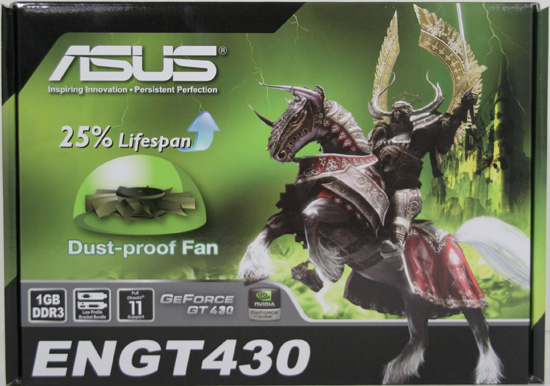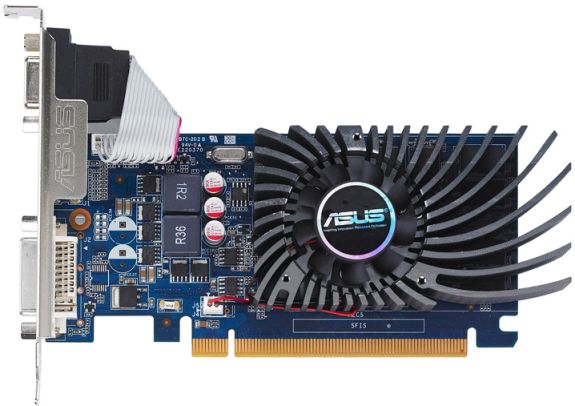NVIDIA's GeForce GT 430: The Next HTPC King?
by Ryan Smith & Ganesh T S on October 11, 2010 9:00 AM ESTMeet the Asus ENGT430
For our look today at the GT 430, Asus graciously provided us with their GT 430 card, the ENGT430. As with all the other cards being released it’s a custom design, featuring the usual Asus design elements: a double-sealed fan, fuse protection, and - while we have a hard time believing this is an issue on such a small card – GPU guard PCB reinforcement.
For this card Asus is very specifically going after the HTPC market. The ENGT430 is a half-height card with a low-profile bracket included, and for cooling it uses a decently sized heatsink with a particularly tiny fan we measure at 36mm. The heatsink does stick up some, so the card is explicitly a double-slot card and you’ll want to make sure you have space for it.
As is the case with low-end cards, reference clocks don’t tend to mean much. While the GT 430 has a reference speed of 700MHz for the core and 1.8GHz effective for the DDR3 memory, Asus has gone ahead and clocked the card at 1.6GHz for the memory. The card is equipped with 8 800MHz (1.6GHz effective) Hynix DDR3 memory modules running in 16bit mode, which is why the card is clocked below NVIDIA’s reference clocks. We expect to see memory clocks all over the place with the launch cards, depending particularly on who could get the best deal on what speed grade of DDR3 RAM for these cards. Given that GT 430 is likely already a memory bandwidth challenged card, this will have an impact, although we don’t have the means to measure it (our card would only go to 1.75GHz on the RAM).

For ports Asus is going with what’s undoubtedly going to be the universal configuration for low-profile GT430 cards: 1x DVI, 1x HDMI, and 1 VGA port. The DVI port is necessary for monitors (without resorting to a dongle), the HDMI port is necessary for HTPC roles, and the VGA port being an easy addition as an optional 3rd port due to its analog nature. GF108 can only drive 2 monitors at once, so the usual restrictions apply.
As is common for budget cards, there’s little else besides the card in the box. Asus includes the low-profile bracket, a multilingual quick installation guide, and a driver CD. This is the first Asus card we’ve reviewed for some time without voltage tweaking capabilities, so even NVIDIA’s integrated overclocking utility is enough for the task.












120 Comments
View All Comments
geok1ng - Tuesday, October 12, 2010 - link
The other consumer grade low cost Blu-Ray Player is the PS3. It qould be nice to have baseline HQV2 numbers for the last firmware of PS3 , so that readers could get a measure of how much picture quality, if any, a HTPC has over a PS3.As for the 3D HTPC card, i simply do not see the owner of a 3D TV using such a low end card. The minimum budget wise is a 768MB 460.
Now NVIDIA should work for a passive card that can beat the 5750 on picture quality, until then it is a PS3 for 3D Bluray and a 5750 for HTPC.
Arnejoh - Tuesday, October 12, 2010 - link
Some of us in here likes to see how new and old Nvidia cards is doing as dedicated Physx cards. There is some tests out there like fluidmark. And i know this is no problem for experts like you @Anandtech :)Hrel - Tuesday, October 12, 2010 - link
Looks like the only card I'd buy for the low end is the HD5670. Slowest card you can buy that allows acceptable gaming and it's a great HTPC card. You can easily find fully silent versions.manokius - Wednesday, October 13, 2010 - link
It's quite simple:an HTPC Must Be Quiet!Power consumption is a factor but most of all you need tranquility when watching movies etc.
So, you need a FANLESS card for not adding noise to the system apart from what the CPU and PSU emits.
What is this then and why is the author giving it the title "HTPC King"?
krumme - Wednesday, October 13, 2010 - link
"The next HTPC King?"Well and the answer to that was pretty much a weak no in my reading.
We have dirt cheap ontario hdmi 1.4, 3d comming with a cpu+gpu for less than this card. This is unfortunately 2 years to late.
dragonsqrrl - Wednesday, October 13, 2010 - link
"unlike all of NVIDIA’s other desktop launches which had GPUs with disabled functional units, the GT 430 uses a fully enabled GF108 GPU. For once with Fermi, we’ll be able to look at the complete capabilities of the GPU."I believe the GTS450 incorporated a fully activated gf106 with 192 SP's, did it not?
Ryan Smith - Thursday, October 14, 2010 - link
All of its SPs, but only 2/3rds of its ROPs and memory controllers.BoonDoggie - Thursday, October 14, 2010 - link
How can any card that cant do decent gaming @ 1920x1080 be called an HTPC card? What a douchebag title. HTPC video cards have to be:A) Able to do video decoding.
B) Do gaming at the defacto standard of 1920x1080.
C) Do it quietly.
NO HTPC card should even be considered unless it can do these. Yes you can get by without gaming, but, since an HTPC can do gaming and console type gaming is regularly seen on the main TV at home, I think it should be a needed quantifier of a decent HTPC card.
Radeth - Monday, November 1, 2010 - link
Hi!I'd like to build an HTPC and I got some questions..These are the specs:
MB: Zotac H55-ITX-A-E
CPU: I3 530 2,92 GHz
RAM: 4Gb DDR3 Kingston SO-DIMM
Optical: LG slim DVD writer
HD: WD Caviar Green Power 500 Gb 3,5"
GPU: Undecided between HD5570 and GT430 or other
What would be the best card to use (even one i didn't mention like GT220) with a 120W power source mini-ITX case?
Thank you
MavAnan - Saturday, November 13, 2010 - link
The review says: "For now, the Radeon HD 5570 is a clear winner from the picture quality standpoint."Does the 5570 also beat the GT240 from the picture quality standpoint?